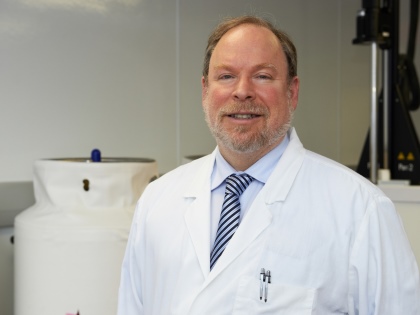You are here
Stem Cells Work Wonders on Baby
Randi Druzin, Freelance Writer
 When he was born at Mount Sinai Hospital in Toronto, Jack was not breathing and was non-responsive. Doctors whisked him away from his mother and started efforts to resuscitate him. They managed to save his life but soon had to deliver some bad news to his parents, Stephen Pankratz and Kim Kucher.
When he was born at Mount Sinai Hospital in Toronto, Jack was not breathing and was non-responsive. Doctors whisked him away from his mother and started efforts to resuscitate him. They managed to save his life but soon had to deliver some bad news to his parents, Stephen Pankratz and Kim Kucher.
Their son had Hypoxic Ischemic Encephalopathy (HIE), brain damage caused by lack of oxygen to the brain and other organs compounded by low blood flow to vital organs. Jack would likely suffer extensive cognitive and physical problems.
Heartbroken, the Oakville couple contacted Toronto-based CReATe Cord Blood Bank, where they had stored blood and tissue stem cells from Jack’s umbilical cord. After consulting with the bank’s laboratory director, Dr. Ayub Lulat, as well as neonatal specialists at The Hospital for Sick Children, the specialists agreed to perform a cutting edge procedure and give Jack an infusion of his own stem cells.
When he was 12 days old Jack became the youngest person ever to undergo stem cell therapy in Canada and the first person in the country to be treated for HIE with stem cells — and he may turn out to be the first of many. In scientific and medical circles, many stem cell experts are predicting the dawn of a new era in the treatment of HIE, autism and other brain disorders.
Two years later, Jack is thriving. He has cerebral palsy and faces many challenges, but his development has exceeded doctor’s expectations. His mother attributes his progress to the transplant.
Early research results treating brain disorders with cord blood stem cells have been encouraging. Stem cells have been effective in treating some cancers and blood disorders. More evidence is needed to prove definitively that they can effectively treat neurological conditions but there is reason to be optimistic.
Dr. Joanne Kurtzberg, a researcher at Duke University in Durham, N.C, is conducting clinical trials to determine whether cord blood can help brain repair in patients. So far, researchers have determined that the procedure is safe.
“Early research results coming from Duke University indicate that early transfusion of cord stem cells is effective,” says Dr. Karen Pape, Jack’s current neonatologist and a neuroscientist who has examined hundreds of children with HIE.
Pankratz and Kucher discovered Kurtzberg’s findings while doing research on HIE in the days following their son’s birth. They brought them to the attention of his neonatologist. “She was open to hearing what we had to say and she read the research findings that we had given her,” says Pankratz. “She came to the same conclusion as us — that the potential benefits of a stem cell transplant outweighed the risks.”
Thanks to those findings and the support of the neonatologist, Jack’s parents were able to persuade doctors at the Hospital for Sick Children to infuse him with his own cord blood stem cells.
“I was very pleasantly surprised that not only was Jack treated with Dr. Kurtzberg's protocol, but that he received the treatment near his home in Canada,” says Dr. Frances Verter, founder and director of the Parent’s Guide to Cord Blood Foundation, a charity and educational resource.
“I hope that more children in Canada will be able to receive cord blood therapy for neurological disorders at hospitals in this country,” she says. “It’s very stressful for families to travel long distances in order for their children to receive cutting edge therapies.
“If more children can benefit from stem cell therapy for HIE shortly after birth, it will lessen the burden on parents and the Canadian health care system to provide for older children with disabilities,” says Dr. Verter, a former astrophysicist who has been working to raise awareness of the stem cells in umbilical cord blood since her daughter Shai died of cancer in 1997.
 “There are children born with debilitating neurological conditions every day in Canada. Many of them will require lifelong care, which will be a strain on their families and on the healthcare system,” adds CReATe Cord Blood Bank’s medical director, Dr. Clifford Librach, who played in integral role in the establishment of the reproductive biology clinical and research programs at Women’s College Hospital in 1991 and, since then, has made significant contributions to fertility practice in Canada.
“There are children born with debilitating neurological conditions every day in Canada. Many of them will require lifelong care, which will be a strain on their families and on the healthcare system,” adds CReATe Cord Blood Bank’s medical director, Dr. Clifford Librach, who played in integral role in the establishment of the reproductive biology clinical and research programs at Women’s College Hospital in 1991 and, since then, has made significant contributions to fertility practice in Canada.
“Being able to provide effective treatment for autism and other diseases of the brain right after birth would be incredibly beneficial, not just to the children themselves but also to their families and to society in general,” he says.
CReATe is a Canadian family cord blood bank. CReATe was founded in 2005 by Dr. Clifford Librach, the Director of CReATe Fertility Centre. CReATe is the only bank in Canada that offers both cord blood and Peristem™ umbilical cord tissue stem cell banking. Umbilical cord tissue derived stem cells have great therapeutic and regenerative potential. Banking both sets of stem cells increases treatment options with cord blood, and also broadens the range of diseases that could be managed with newborn stem cells.


